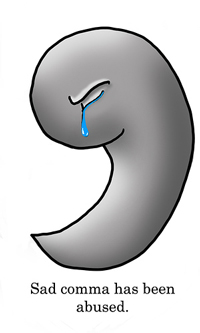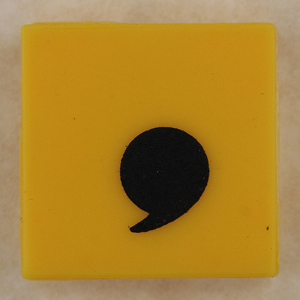With so many comma rules, it’s difficult to know where to begin. Do you use the “salt and pepper” method of inserting commas—“shaking” commas into your sentences anywhere and for any reason, thinking you will impress your readers? One basic rule of thumb is that when you read a sentence aloud, the places where you pause probably need commas for the sake of clarity. We’re not going to cover all the rules in this lesson, but we will cover some of the more common ones that you should know. You may want to review the lessons in the Related Resources titled Punctuation and Restrictive/Nonrestrictive Clauses and Punctuation of Contrasting Expressions to refresh your memory.

Source: Sad comma, Caylin, Flickr
The following are some basic rules regarding comma usage:
- Use commas to separate elements in a series (i.e., a list of three or more words).
Example: We took hot dogs, chips, and deviled eggs on our picnic.
- Use a comma after an introductory word, phrase, or clause, such as a contrasting expression, in a sentence.
Example: We were all exhausted. However, we continued our hike. (introductory word)
Example: After the rain diminished, we were able to enjoy the outdoors. (introductory clause)
- Use commas in dates and addresses to separate the elements.
Example: Tuesday, May 4, 2013, is the last day of the spring semester. (Note that the month and day do not have a comma between them.)
Example: My address is 4209 South Lake, Indianapolis, Indiana. (Note that the number and street name do not have a comma between them.)
- Use a comma before a conjunction to separate two independent clauses in a compound sentence.
Example: Sam talked, and his parents listened.
- Use a comma after the greeting and closing of letters and more formal e-mails.
Example: Dear Aunt Joan,
Example: Sincerely yours,
- Use a comma to set off nonrestrictive phrases and clauses.
Example: Checkers, which is played in many countries, is an easy game to learn. (The phrase “which is played in many countries” is not essential to the rest of the sentence. Without the phrase, you still have a complete sentence that makes sense: Checkers is an easy game to learn.

Source: comma, LEOL30, Flickr
The rules listed above are some of the more basic rules related to comma usage. Use the sentences below to practice. All the commas have been removed. Click where you think a comma should go, and if you are correct, it will appear.

Did you insert commas in the correct places? You will have another chance at the end of this lesson to practice more with comma placement.